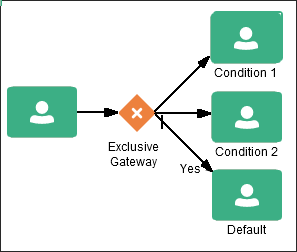Work with Sequence Flows
Sequence flows define the order or sequence that work is performed within a business process. Sequence flows connect the activities within your business process and determine the path a process token follows through your business process.
Incoming sequence flows are the sequence flows that lead into an activity. Outgoing sequence flows are the sequence flows that determine the process path out of an activity.
Most activities contain both incoming and outgoing sequence flows. Exceptions to this are start and end events. Start events can only contain outgoing sequence flows. End events can only contain incoming sequence flows.
Unconditional Sequence Flows
Unconditional sequence flows represent the typical path between two activities. Default sequence flows are displayed as arrows:
Most activities can contain only one default outgoing sequence flow. Only parallel gateways can contain multiple unconditional sequence flows, which represent the parallel paths of your business process.
Exclusive and inclusive gateways can’t have unconditional outgoing sequence flows. These gateways use conditional and default sequence flows to determine the flow of your business process.
Conditional Sequence Flows
Use conditional sequence flows to control the flow of a business process based on certain conditions. Like unconditional sequence flows, conditional sequence flows are represented by an arrow.
Here’s an example of two outgoing conditional sequence flows and a default sequence flow (which includes a slash mark at the beginning of its arrow):

Description of the illustration conditional-flow.png
Not all activities can use outgoing conditional sequence flows. Only the following types of gateways can have outgoing conditional sequence flows:
-
Exclusive gateways
-
Inclusive gateways (split)
You use expressions to define the conditions used within a conditional sequence flow.
Default Sequence Flows
Like conditional sequence flows, default sequence flows are used as outgoing sequence flows to exclusive, event-based, inclusive, and conditional gateways.
Default sequence flows represent the path your business process takes out of these gateways when none of the conditions evaluate to true. Default sequence flows are represented by an arrow with a slash mark on one end.